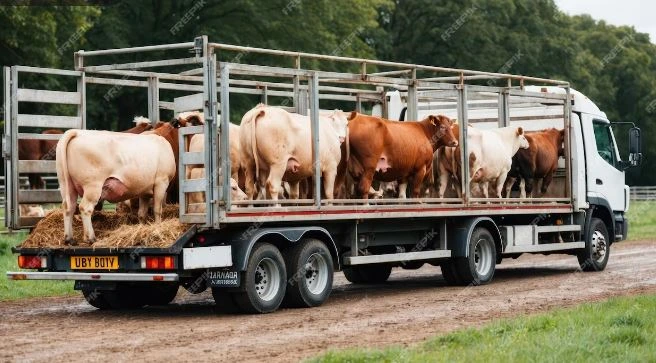Shipping livestock overseas involves a complex web of regulations, logistics, animal welfare standards, and transportation procedures. At JCS Livestock, we specialise in managing these processes efficiently and in full compliance with international standards.
In this blog, we provide a comprehensive overview of how to ship livestock overseas, covering everything from legal documentation to choosing the right transport method.
Overseas Livestock Transport: Key Legal Requirements
International livestock transport is regulated by stringent laws for animal health, safety, and traceability. Each country has its own import regulations, and compliance is non-negotiable.
Export Health Certificates and Veterinary Inspection
Before any livestock can be shipped overseas, a licensed veterinarian must inspect the animals and issue an Export Health Certificate (EHC). This document verifies the animals are disease-free and fit for travel. Most countries require:
- Certification from an official government-appointed veterinarian.
- Documentation of vaccination history, health status, and microchipping (if required).
- Proof of disease testing, such as brucellosis or tuberculosis.
Import Permits and Destination Requirements
The importing country typically issues an Import Permit, outlining specific health, welfare, and quarantine conditions. It is critical to:
- Check country-specific requirements with the destination's ministry of agriculture.
- Ensure compatibility between the export and import regulations.
- Secure approvals well in advance to prevent shipment delays.
Livestock Transport Overseas: Methods of Transport
Choosing the proper method of transport is essential for the safety, comfort, and well-being of animals during the journey.
Air Freight for Livestock
Air transportation is the fastest and most commonly used method for shipping livestock internationally. It is ideal for valuable breeding stock, horses, cattle, and small livestock like sheep or goats.
Benefits of air freight include:
- Shorter transit time reduces animal stress.
- Special livestock crates and containers ensure safety.
- Major airlines offer livestock-specific cargo services.
Sea Freight for Large-Scale Shipments
For large herds or longer distances, sea freight is a more economical option. Specialized livestock vessels are equipped with:
- Climate control and ventilation systems.
- Automated feeding and watering.
- Trained livestock handlers onboard.
While cost-effective, sea freight requires careful planning due to longer transit times and the need for mid-journey veterinary care.

Animal Welfare Compliance and Transport Conditions
Maintaining animal welfare during transportation is a legal and ethical obligation. Livestock must be transported under conditions that minimize stress, injury, and disease transmission.
Approved Crates and Containers
All animals must be transported in IATA-approved containers (for air) or vessel-approved pens (for sea). Crates should:
- Allow animals to stand, lie down, and turn around comfortably.
- Include non-slip flooring, adequate bedding, and secure locks.
- Be designed for ventilation and waste drainage.
Feeding, Watering, and Resting Protocols
Livestock must have access to sufficient food and water throughout the journey. Regulations often stipulate:
- Pre-loading fasting to reduce waste in transit.
- Automatic or manual watering systems.
- Scheduled rest periods on long journeys or layovers.
Pre-Transport Preparation and Quarantine
Proper preparation is vital for a successful overseas shipment of livestock. This includes quarantine, identification, and acclimatization procedures.
Quarantine Requirements
Many destination countries enforce pre-export and post-arrival quarantine periods to prevent disease outbreaks. Steps include:
- Isolation in approved quarantine facilities.
- Regular health checks and monitoring.
- Compliance with specific quarantine durations (ranging from 7 to 30+ days).
Animal Identification and Records
Each animal must be individually identified using:
- Ear tags, microchips, or tattoos.
- A logbook of health checks, vaccinations, and medical treatments.
- Official transport manifests and customs declarations.
Working with Professional Livestock Transporter
Hiring a licensed, experienced livestock transport company can significantly streamline the process and prevent costly mistakes.
Why Choose JCS Livestock
We provide:
- Door-to-door logistics, including pickup and delivery.
- 24/7 customer service and real-time shipment tracking.
- Expert documentation support for EHCs, permits, and customs.
- Compliance with all international livestock transport laws.
We also coordinate with airlines, sea carriers, and veterinary authorities to make animals' journey safe, legal, and efficient.
Documentation Checklist for International Livestock Shipping
Before transporting livestock internationally, ensure the following documents are ready and valid:
- Export Health Certificate (EHC)
- Import Permit from destination country
- Quarantine clearance certificate
- Vaccination and health records
- Animal identification documents
- Transport manifest and loading list
- Carrier's Certificate of Insurance
- Bill of Lading or Air Waybill
Top Tips for Successful Livestock Shipping
- Plan early – international livestock shipping can take weeks of preparation.
- Consult destination authorities – regulations can change without notice.
- Use accredited shippers – avoid legal and welfare issues.
- Monitor animal health closely – stress, dehydration, and illness can affect fitness for travel.
- Stay informed about disease outbreaks – they can delay or halt shipments.
Conclusion
International livestock shipping demands precise coordination, deep regulatory knowledge, and a strong commitment to animal welfare.
At JCS Livestock, we take pride in offering safe, legal, and humane overseas shipping solutions tailored to your specific livestock needs. Whether it’s cattle, sheep, goats, pigs, or horses, we handle it all with the utmost professionalism and care.
More Resources:
